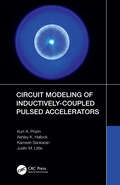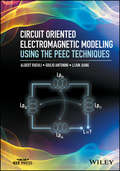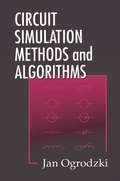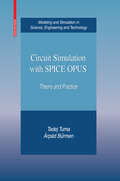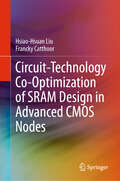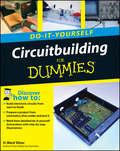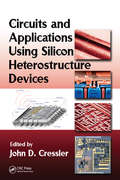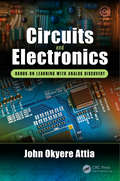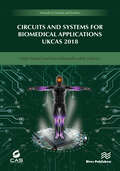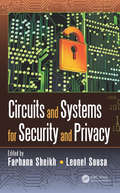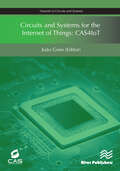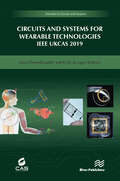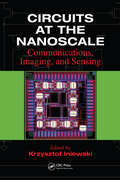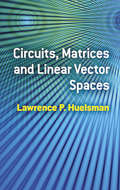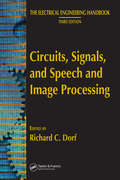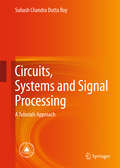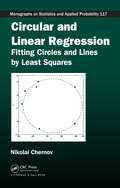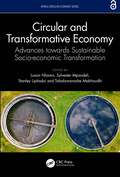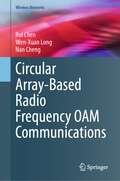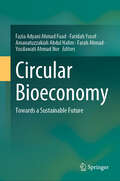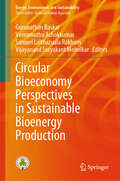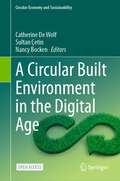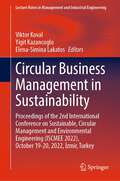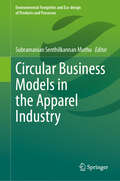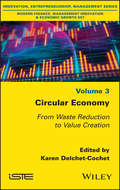- Table View
- List View
Circuit Modeling of Inductively-Coupled Pulsed Accelerators
by Kurt A. Polzin Ashley K. Hallock Kamesh Sankaran Justin M. LittleThis monograph describes lumped-element modelling techniques for inductively-coupled pulsed accelerators, starting from the basic physical description of the various processes and then bringing all the pieces together into solutions. Coilguns, inductive pulsed plasma thrusters, and compact toroids have each been individually studied using the methods used in this monograph. This monograph is of interest to researchers and graduate students in physics, engineering, and mathematics presently studying inductively-coupled pulsed accelerators.Features The first book to unify the lumped-element modelling techniques for various inductively-coupled pulsed accelerator implementations. Discussion of modelling different accelerators in a coherent, rigorous manner, demonstrating the similarities and differences for each type. Authored by authorities in the field.
Circuit Oriented Electromagnetic Modeling Using the PEEC Techniques
by Albert Ruehli Giulio Antonini Lijun JiangBridges the gap between electromagnetics and circuits by addressing electrometric modeling (EM) using the Partial Element Equivalent Circuit (PEEC) method This book provides intuitive solutions to electromagnetic problems by using the Partial Element Equivalent Circuit (PEEC) method. This book begins with an introduction to circuit analysis techniques, laws, and frequency and time domain analyses. The authors also treat Maxwell's equations, capacitance computations, and inductance computations through the lens of the PEEC method. Next, readers learn to build PEEC models in various forms: equivalent circuit models, non-orthogonal PEEC models, skin-effect models, PEEC models for dielectrics, incident and radiate field models, and scattering PEEC models. The book concludes by considering issues like stability and passivity, and includes five appendices some with formulas for partial elements. Leads readers to the solution of a multitude of practical problems in the areas of signal and power integrity and electromagnetic interference Contains fundamentals, applications, and examples of the PEEC method Includes detailed mathematical derivations Circuit Oriented Electromagnetic Modeling Using the PEEC Techniques is a reference for students, researchers, and developers who work on the physical layer modeling of IC interconnects and Packaging, PCBs, and high speed links.
Circuit Simulation Methods and Algorithms (Electronic Engineering Systems #4)
by Jan OgrodzkiCircuit Simulation Methods and Algorithms provides a step-by-step theoretical consideration of methods, techniques, and algorithms in an easy-to-understand format. Many illustrations explain more difficult problems and present instructive circuits. The book works on three levels:The simulator-user level for practitioners and students who want to better understand circuit simulators. The basic theoretical level, with examples, dedicated to students and beginning researchers. The thorough level for deep insight into circuit simulation based on computer experiments using PSPICE and OPTIMA. Only basic mathematical knowledge, such as matrix algebra, derivatives, and integrals, is presumed.
Circuit Simulation with SPICE OPUS: Theory and Practice (Modeling and Simulation in Science, Engineering and Technology)
by Tadej Tuma Árpád BuermenThis book is a unique combination of a basic guide to general analog circuit simulation and a SPICE OPUS software manual, which may be used as a textbook or self-study reference. The book is divided into three parts: mathematical theory of circuit analysis, a crash course on SPICE OPUS, and a complete SPICE OPUS reference guide. All simulations as well as the free simulator software may be directly downloaded from the SPICE OPUS homepage: www.spiceopus.si. Circuit Simulation with SPICE OPUS is intended for a wide audience of undergraduate and graduate students, researchers, and practitioners in electrical and systems engineering, circuit design, and simulation development.
Circuit-Technology Co-Optimization of SRAM Design in Advanced CMOS Nodes
by Hsiao-Hsuan Liu Francky CatthoorModern computing engines—CPUs, GPUs, and NPUs—require extensive SRAM for cache designs, driven by the increasing demand for higher density, performance, and energy efficiency. This book delves into two primary areas within ultra-scaled technology nodes: (1) advancing SRAM bitcell scaling and (2) exploring innovative subarray designs to enhance power-performance-area (PPA) metrics across technology nodes. The first part of the book utilizes a bottom-up design-technology co-optimization (DTCO) approach, employing a dedicated PPA simulation framework to evaluate and identify the most promising strategies for SRAM bitcell scaling. It offers a comprehensive examination of SRAM bitcell scaling beyond 1 nm node, outlining a structured research cycle that includes identifying scaling bottlenecks, developing cutting-edge architectures with complementary field-effect transistor (CFET) technology, and addressing challenges such as process integration and routing complexities. Additionally, this book introduces a novel write margin methodology to better address the risks of write failures in resistance-dominated nodes. This methodology accounts for time-dependent parasitic bitline effects and incorporates timing setup of write-assist techniques to prevent underestimating the yield loss. In the second part, the focus shifts to a top-down DTCO approach due to the diminishing returns of bitcell scaling beyond 5 Å node at the macro level. As technology scales, increasing resistance and capacitance (RC) lead designers to adopt smaller subarray sizes to reduce effective RC and enhance subarray-level PPA. However, this approach can result in increased inter-subarray interconnect overhead, potentially offsetting macro-level improvements. This book examines the effects of various subarray sizes on macro-level PPA and finds that larger subarrays can significantly reduce interconnect overhead and improve the energy-delay-area product (EDAP) of SRAM macro. The introduction of the active interconnect (AIC) concept enables the use of larger subarray sizes, while integrating carbon nanotube FET as back-end-of-line compatible devices results in macro-level EDAP improvements of up to 65% when transitioning from standard subarrays to AIC divided subarrays. These findings highlight the future trajectory of SRAM subarray design in deeply scaled nodes.
Circuitbuilding Do-It-Yourself For Dummies
by H. Ward SilverDO-IT-YOURSELFHere's the fun and easy way to start building circuits for your projectsHave you ever wanted to build your own electronic device? Put together a thermostat or an in-line fuse, or repair a microphone cable? This is the book for you! Inside you'll find the tools and techniques you need to build circuits, with illustrated, step-by-step directions to help accomplish tasks and complete projects.As you accomplish the tasks throughout the book, you'll construct many projects while learning the key circuitbuilding principles and techniques. Find out about measuring and testing, maintenance and troubleshooting, cables, connectors, how to test your stuff, and more.Stuff You Need to Know*The tools you need and how to use them*How to make sense of schematics and printed circuit boards*Basic techniques for creating any circuit*How to make and repair cables and connectors*Testing and maintenance procedures
Circuits and Applications Using Silicon Heterostructure Devices
by John D. CresslerNo matter how you slice it, semiconductor devices power the communications revolution. Skeptical? Imagine for a moment that you could flip a switch and instantly remove all the integrated circuits from planet Earth. A moment’s reflection would convince you that there is not a single field of human endeavor that would not come to a grinding halt, be it commerce, agriculture, education, medicine, or entertainment. Life, as we have come to expect it, would simply cease to exist. Drawn from the comprehensive and well-reviewed Silicon Heterostructure Handbook, this volume covers SiGe circuit applications in the real world. Edited by John D. Cressler, with contributions from leading experts in the field, this book presents a broad overview of the merits of SiGe for emerging communications systems. Coverage spans new techniques for improved LNA design, RF to millimeter-wave IC design, SiGe MMICs, SiGe Millimeter-Wave ICs, and wireless building blocks using SiGe HBTs. The book provides a glimpse into the future, as envisioned by industry leaders.
Circuits and Electronics: Hands-on Learning with Analog Discovery
by John Okyere AttiaThe book provides instructions on building circuits on breadboards, connecting the Analog Discovery wires to the circuit under test, and making electrical measurements. Various measurement techniques are described and used in this book, including: impedance measurements, complex power measurements, frequency response measurements, power spectrum measurements, current versus voltage characteristic measurements of diodes, bipolar junction transistors, and Mosfets. The book includes end-of-chapter problems for additional exercises geared towards hands-on learning, experimentation, comparisons between measured results and those obtained from theoretical calculations.
Circuits and Systems for Biomedical Applications: UKCAS 218
by Hadi Heidari; Sara GhoreishizadehCircuits and Systems for Biomedical Applications-UKCAS 2018 covers several advanced topics in the area of Devices, Analog and Mixed-Signal Circuits and Systems for Biomedical Applications. The fundamental aspects of these topics are discussed, and state-of-the-art developments are presented. The book proceeds the 1st United Kingdom Circuits and Systems (UKCAS 2018) Workshop. It addresses multidisciplinary theme areas such as Biosensing, Memristors, next-generation medical diagnostics, neural-inspired circuits, neural implants, neuro-prostheses, prosthetic hand and neuro-rehabilitation. Having perceived the device and circuit assets for such technologies and knowing what challenges these present for the biomedical scientists and engineers, integrated circuits for addressable biosensing are reviewed in the first chapter. The Second Chapter is harnessing the power of the brain using metaloxide Memristors. The third chapter contains construction of an endoscopic capsule for the diagnostics of dysmotilities in the gastrointestinal track. The next three chapters are on neural interfaces: analogue building blocks of neural inspired circuits are described in the fourth chapter while chapter five focuses on circuits for bio-potential recording from the brain. Networked Integrated circuits and their use in creating advanced implantable stimulation systems will be discussed in chapter six. This topic will be completed by circuits and systems for control of Prosthetic Hands in seventh chapter and genetically enhanced brainimplants for neuro-rehabilitation in chapter eight.
Circuits and Systems for Security and Privacy (Devices, Circuits, and Systems)
by Farhana Sheikh Leonel SousaCircuits and Systems for Security and Privacy begins by introducing the basic theoretical concepts and arithmetic used in algorithms for security and cryptography, and by reviewing the fundamental building blocks of cryptographic systems. It then analyzes the advantages and disadvantages of real-world implementations that not only optimize power, area, and throughput but also resist side-channel attacks. Merging the perspectives of experts from industry and academia, the book provides valuable insight and necessary background for the design of security-aware circuits and systems as well as efficient accelerators used in security applications.
Circuits and Systems for the Internet of Things: CAS4IoT
by João GoesInternet-of-Things (IoT) can be envisaged as a dynamic network of interconnected physical and virtual entities (things), with their own identities and attributes, seamlessly integrated in order to e.g. actively participate in economic or societal processes, interact with services, and react autonomously to events while sensing the environment. By enabling things to connect and becoming recognizable, while providing them with intelligence, informed and context based decisions are expected in a broad range of domains spanning from health and elderly care to energy efficiency, either providing business competitive advantages to companies, either addressing key social concerns. The level of connectivity and analytical intelligence provided by the IoT paradigm is expected to allow creating new services that would not be feasible by other means. This CAS4IoT book targets post-graduate students and design engineers, with the skills to understand and design a broader range of analog, digital and mixed-signal circuits and systems, in the field of IoT, spanning from data converters for sensor interfaces to radios, ensuring a good balance between academia and industry, combined with a judicious selection of worldwide distinguished authors.
Circuits and Systems for Wearable Technologies: IEEE UKCAS 219
by Sara Ghoreishizadeh Kylie De JagerThis book is based on presentations given at the 2nd IEEE United Kingdom Circuits and Systems (UKCAS 2019) Workshop. It covers several advanced topics in the areas of semiconductor devices, circuits and systems, and energy harvesting; discussing their application in emerging implantable and wearable technologies and IoT. Notable application examples discussed include rapid infectious disease monitoring, in-situ tear fluid analysis, sleep engineering, chronic pain treatment, personalised anti-cancer therapy, foetus and neonate monitoring, monitoring of bone healing, orthopedic implants, magnetomyography and intelligent gesture recognition. Fundamental aspects of these topics are discussed, and state-of-the-art developments are presented.
Circuits at the Nanoscale: Communications, Imaging, and Sensing (Devices, Circuits, and Systems)
by Krzysztof IniewskiCircuits for Emerging Technologies Beyond CMOS New exciting opportunities are abounding in the field of body area networks, wireless communications, data networking, and optical imaging. In response to these developments, top-notch international experts in industry and academia present Circuits at the Nanoscale: Communications, Imaging, and Sensing. This volume, unique in both its scope and its focus, addresses the state-of-the-art in integrated circuit design in the context of emerging systems. A must for anyone serious about circuit design for future technologies, this book discusses emerging materials that can take system performance beyond standard CMOS. These include Silicon on Insulator (SOI), Silicon Germanium (SiGe), and Indium Phosphide (InP). Three-dimensional CMOS integration and co-integration with Microelectromechanical (MEMS) technology and radiation sensors are described as well. Topics in the book are divided into comprehensive sections on emerging design techniques, mixed-signal CMOS circuits, circuits for communications, and circuits for imaging and sensing. Dr. Krzysztof Iniewski is a director at CMOS Emerging Technologies, Inc., a consulting company in Vancouver, British Columbia. His current research interests are in VLSI ciruits for medical applications. He has published over 100 research papers in international journals and conferences, and he holds 18 international patents granted in the United States, Canada, France, Germany, and Japan. In this volume, he has assembled the contributions of over 60 world-reknown experts who are at the top of their field in the world of circuit design, advancing the bank of knowledge for all who work in this exciting and burgeoning area.
Circuits, Matrices and Linear Vector Spaces (Dover Books on Electrical Engineering)
by Lawrence P. HuelsmanThis high-level undergraduate text explains the mathematics behind basic circuit theory. Its self-contained treatment covers matrix algebra, which provides a general means of formulating the details of a linear system. In addition, the author presents the basic theory of n-dimensional spaces and demonstrates its application to linear systems. A development of the mathematics of matrix algebra and determinants is followed by the application of matrix techniques to a general discussion of circuits. Subsequent topics include the properties of active and passive two-port devices, the basic theory of linear vector spaces, and the natural frequencies of a network. Appendixes cover the indefinite-transfer matrix, gyrators with complex gyration admittance, and network transformations. A wealth of equations and calculation problems appear throughout the text.
Circuits, Signals, and Speech and Image Processing (The Electrical Engineering Handbook)
by Richard C. DorfIn two editions spanning more than a decade, The Electrical Engineering Handbook stands as the definitive reference to the multidisciplinary field of electrical engineering. Our knowledge continues to grow, and so does the Handbook. For the third edition, it has expanded into a set of six books carefully focused on a specialized area or field of study. Each book represents a concise yet definitive collection of key concepts, models, and equations in its respective domain, thoughtfully gathered for convenient access.Circuits, Signals, and Speech and Image Processing presents all of the basic information related to electric circuits and components, analysis of circuits, the use of the Laplace transform, as well as signal, speech, and image processing using filters and algorithms. It also examines emerging areas such as text-to-speech synthesis, real-time processing, and embedded signal processing. Each article includes defining terms, references, and sources of further information.Encompassing the work of the world's foremost experts in their respective specialties, Circuits, Signals, and Speech and Image Processing features the latest developments, the broadest scope of coverage, and new material on biometrics.
Circuits, Systems and Signal Processing: A Tutorials Approach
by Suhash Chandra Dutta RoyThis book is a collection of tutorial-like chapters on all core topics of signals and systems and the electronic circuits. All the topics dealt with in the book are parts of the core syllabi of standard programs in Electrical Engineering, Electrical and Computer Engineering, and Electronics and Telecommunication Engineering domains. This book is intended to serve as a secondary reader or supplementary text for core courses in the area of signals and systems, electronic circuits, and analog and digital signal processing. When studying or teaching a particular topic, the students and instructors of such courses would find it interesting and worthwhile to study the related tutorial chapter in this book in order to enhance their understanding of the fundamentals, simplification of procedures, alternative approaches and relation to other associated topics. In addition, the book can also be used as a primary or secondary text in short-term or refresher courses, and as a self-study guide for professionals wishing to gain a comprehensive review of the signals and systems domain.
Circular and Linear Regression: Fitting Circles and Lines by Least Squares (Chapman & Hall/CRC Monographs on Statistics and Applied Probability)
by Nikolai ChernovFind the right algorithm for your image processing applicationExploring the recent achievements that have occurred since the mid-1990s, Circular and Linear Regression: Fitting Circles and Lines by Least Squares explains how to use modern algorithms to fit geometric contours (circles and circular arcs) to observed data in image processing and comput
Circular and Transformative Economy: Advances towards Sustainable Socio-economic Transformation (Africa Circular Economy Series)
by Nhamo Luxon Sylvester Mpandeli Stanley Liphadzi Tafadzwanashe MabhaudhiThe main aim of this book is to illustrate circular models for sustainable resource management. It highlights the benefits of transformative approaches in integrating, simplifying, and facilitating understanding of complex systems and transforming systems towards greater sustainability while achieving multiple social, economic, and environmental outcomes. It provides pathways towards strategic policy decisions on socio-economic transformation supported by case studies.Features: Discusses exploration of a transitional path to the circular economy, explored from the point of view of waste and technology. Explains transformational change towards sustainable socio-ecological interactions. Reviews provision of pathways towards sustainability through scenario development. Provides assessment of progress towards Sustainable Development Goals. Presents cross-sectoral and multicentric approaches towards circularity. This book is aimed at researchers and professionals in water and environmental engineering, circular economy, sustainability, and environmental studies.
Circular Array-Based Radio Frequency OAM Communications (Wireless Networks)
by Rui Chen Wen-Xuan Long Nan ChengThis book presents the modeling and transmission theory of RF OAM communications. The book features the UCA-based RF point-to-point OAM communication system, the UCA-based RF point-to-multipoint OAM wireless backhaul network, the HCCL structure for long-distance OAM transmissions, and the UCA-based joint OAM RadCom scheme. For the UCA-based RF point-to-point OAM communication system, a 2-D ESPRIT-based distance and AoA estimation method is first introduced, followed by an OAM reception scheme including the hybrid mechanical and electronic beam steering with the estimated AoA and the amplitude detection with the estimated distance. The proposed RF OAM communication scheme is extended to the RF OAM-MIMO system equipped with UCCAs. For the UCA-based RF point-to-multipoint OAM wireless backhaul network, an OAM-based multi-user distance and AoA estimation method is introduced, followed by a multi-user OAM preprocessing scheme. At last, the proposed methods are extended to the downlink multi-user OAM-MIMO wireless backhaul system equipped with UCCAs. Moreover, a novel HCCL structure is introduced to realize long-distance OAM transmission. For the UCA-based joint OAM RadCom scheme, an OAM-based 3-D super-resolution position estimation and rotation velocity detection method is introduced, and then the PCRB of the OAM-based estimates and the transmission rate of the integrated system are derived and analyzed. To achieve the best performance trade-off, the transmitted integrated OAM beams is optimized by means of an exhaustive search method. Finally, this book discusses future research directions to inspire further investigation in the field of RF OAM communications from different perspectives.
Circular Bioeconomy: Towards a Sustainable Future
by Fazia Adyani Ahmad Fuad Faridah Yusof Amanatuzzakiah Abdul Halim Farah Ahmad Yusilawati Ahmad NorThis book highlights the efforts made to realize the concept of ‘Circular Bioeconomy’. It has twelve (12) chapters, focussed on five (5) sections, namely Biomaterials, Environment, Energy, Pharmaceutical and Enzyme Technology. It portrays research, linking ‘Circular Bioeconomy’ to the United Nation’s Sustainable Development Goals (SDGs). The concept of ‘Circular Economy’, including ‘Circular Bioeconomy’, aims to shift the current, essentially linear economic system to a more sustainable one. Accordingly, the key goal of a ‘Circular Economy’ is to slow, narrow and close material resource loops, built on the foundation of renewable energy and non-toxic materials. Further, a sustainable ‘Bioeconomy’ goes beyond simply switching fossil resources with renewable, biological resources. It requires low-carbon energy inputs, sustainable supply chains and promising disruptive conversion technologies for the sustainable transformation of renewable bioresources to high-value bio-based products, materials and fuels. Thus, a sustainable ‘Circular Bioeconomy’ transition will necessitate a set of consistent metrics that fit all products and industries.
Circular Bioeconomy Perspectives in Sustainable Bioenergy Production (Energy, Environment, and Sustainability)
by Samuel Lalthazuala Rokhum Vijayanand Suryakant Moholkar Gurunathan Baskar Veeramuthu AshokkumarThis book covers the various technological developments and challenges in converting biomass residues into different forms of bioenergy. The continuous increase in the world population increased the demand for food products. The incorporation of modern technologies in agriculture increased the production of various food products, ending with excess generation of agricultural biomass residues from primary and secondary agriculture industries. Since, these biomass residues are a rich source of valuable bioproducts, they can be converted into various forms of bioenergy, such as biogas, biochar, biooil, biodiesel, and bioethanol. Besides, this approach is expected to address the gaps in biomass residue management and transformation to valuable bioproducts, and it also enhances the circular economy perspective. The book can be a valuable reference for beginners, researchers, and professionals interested in sustainable construction and allied fields.
A Circular Built Environment in the Digital Age (Circular Economy and Sustainability)
by Catherine De Wolf Sultan Çetin Nancy BockenThis open access book offers a comprehensive exploration of the digital innovations that have emerged in recent years for the circular built environment. Each chapter is meticulously crafted to ensure that both academic readers and industry practitioners can grasp the inner workings of each digital technology, understand its relevance to the circular built environment, examine real-life implementations, and appreciate the intriguing business models behind them. Our primary objective is to blend scholarly knowledge with practical inspiration by providing real-life case studies for each innovation. The authors, who possess extensive expertise in their respective fields, have contributed chapters dedicated to digital technologies within their areas of specialization. The book is organized into three distinct parts. The first part focuses on data-driven digital technologies and delves into how their capabilities can facilitate the transition to a circular built environment. Essential aspects such as building information modeling (BIM), digital twins, geographical information systems (GIS), scanning technologies, artificial intelligence (AI), data templates, and material passports are explored as vital tools for data collection, integration, and analysis in the context of circular construction. In the second part, various digital technologies for design and fabrication are introduced. Topics covered include computational design algorithms, additive and subtractive manufacturing, robotic manufacturing, and extended reality. These discussions shed light on how these technologies can be leveraged to enhance design and fabrication processes within the circular built environment. Finally, the last part of the book presents emerging digital concepts related to business and governance. It explores the role of deconstruction and reverse logistics, blockchain technology, digital building logbooks, and innovative business models as enablers of circularity in the built environment. The book concludes with a chapter dedicated to digital transformation and its potential to propel the built environment towards a regenerative future. In addition to the substantive content, the book features forewords and perspectives from esteemed experts, providing valuable economic and creative insights to complement its comprehensive approach.
Circular Business Management in Sustainability: Proceedings of the 2nd International Conference on Sustainable, Circular Management and Environmental Engineering (ISCMEE 2022), October 19–20, 2022, İzmir, Turkey (Lecture Notes in Management and Industrial Engineering)
by Viktor Koval Yigit Kazancoglu Elena-Simina LakatosThis book gathers research and best-practices concerning the achievement of sustainable development goals in both community generation and business growth. It highlights the organizational aspects relating to the realization of green innovation. It covers models for optimizing the use of both natural and human resources. It reports on assessment methods and advanced models to analyze community and business performance in the context of sustainable development. Further, it proposes solutions to reduce the effects of environmental pollution, increase energy efficiency, and managing resources and waste, to foster sustainable development. Gathering the proceedings of the 2nd International Conference on Sustainable, Circular Management and Environmental Engineering (ISCMEE 2022), held on October 19-20, 2022, as a hybrid event from İzmir, Turkey, this book offers a timely snapshot on circular business management knowledge and methods for both researchers and professionals in the field of engineering management, business and economics, and energy and environment.
Circular Business Models in the Apparel Industry (Environmental Footprints and Eco-design of Products and Processes)
by Subramanian Senthilkannan MuthuThis volume offers a variety of cases dealing with circular business models in the textile and fashion industry. The cases cover the circularity, circular business models relevant to the apparel industry. In addition, this book presents a comprehensive examination of circular economy principles within the textile and apparel industry, emphasizing sustainability and innovation through various lenses.
Circular Economy: From Waste Reduction to Value Creation
by Karen Delchet-CochetThis book is aimed at companies, researchers, consultants, consumers, students and any interested public interested in the subject, the reflections and practices of the circular economy. As part of the draft law on the circular economy in France, the authors (researchers and experts) analyze the data and the reflections and base their arguments on real examples in order to propose solutions and recommendations for a green economy. It gives an updated overview of the reflections and practices around the circular economy. The book is divided into three parts: - The company and its functions, innovative business models - The institutional, legislative and normative framework - Some sectors of activity with the prism of the circular economy
